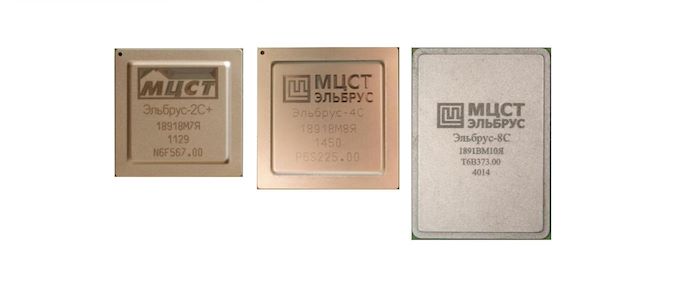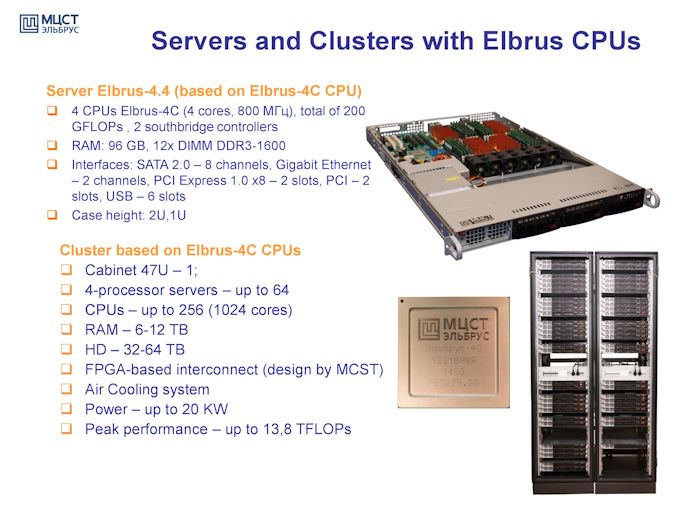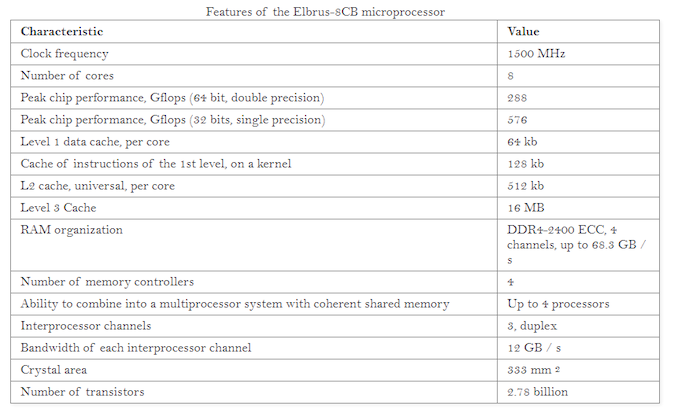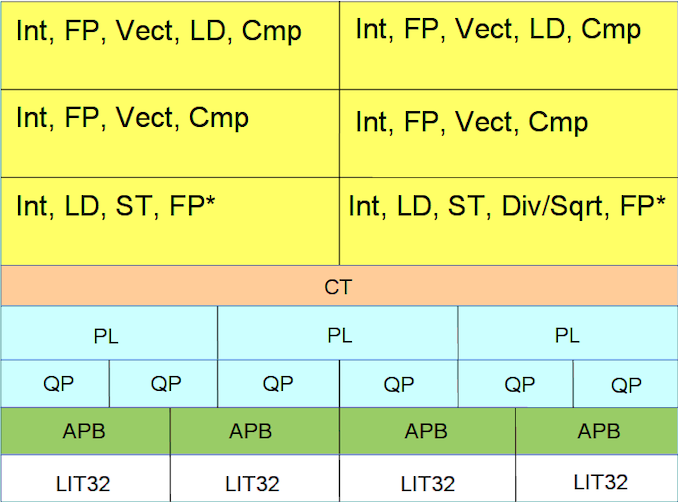Russia’s Elbrus 8CB Microarchitecture: 8-core VLIW on TSMC 28nm
by Dr. Ian Cutress on June 1, 2020 8:00 AM EST
All of the world’s major superpowers have a vested interest in building their own custom silicon processors. The vital ingredient to this allows the superpower to wean itself off of US-based processors, guarantee there are no supplemental backdoors, and if needed add their own. As we have seen with China, custom chip designs, x86-based joint ventures, or Arm derivatives seem to be the order of the day. So in comes Russia, with its custom Elbrus VLIW design that seems to have its roots in SPARC.
Russia has been creating processors called Elbrus for a number of years now. For those of us outside Russia, it has mostly been a big question mark as to what is actually under the hood – these chips are built for custom servers and office PCs, often at the direction of the Russian government and its requirements. We have had glimpses of the design, thanks to documents from Russian supercomputing events, however these are a few years old now. If you are not in Russia, you are unlikely to ever get your hands on one at any rate. However, it recently came to our attention of a new programming guide listed online for the latest Elbrus-8CB processor designs.
The latest Elbrus-8CB chip, as detailed in the new online programming guide published this week, built on TSMC’s 28nm, is a 333 mm2 design featuring 8 cores at 1.5 GHz. Peak throughput according to the documents states 576 GFLOPs of single precision, with the chip offering four channels of DDR4-2400, good for 68.3 GB/s. The L1 and L2 caches are private, with a 64 kB L1-D cache, a 128 kB L1-I cache, and a 512 kB L2 cache. The L3 cache is shared between the cores, at 2 MB/core for a total of 16 MB. The processor also supports 4-way server multiprocessor combinations, although it does not say on what protocol or what bandwidth.
It is a compiler focused design, much like some other complex chips, in that most of the optimizations happen at the compiler level. Based on compiler first designs in the past, that typically does not make for a successful product. Documents from 2015 state that a continuing goal of the Elbrus design is x86 and x86-64 binary translation with only a 20% overhead, allowing full support for x86 code as well as x86 operating systems, including Windows 7 (this may have been updated since 2015).
The core has six execution ports, with many ports being multi-capable. For example, four of the ports can be load ports, and two of the ports can be store ports, but all of them can do integer operations and most can do floating point operations. Four of the ports can do comparison operations, and those four ports can also do vector compute.
This short news post is not meant to be a complete breakdown of the Elbrus capabilities – we have amusingly joked internally at what frequency a Cortex X1 with x86 translation would match the capabilities of the 8-core Elbrus, however users who want to get to grips with the design can open and read the documentation at the following address:
http://ftp.altlinux.org/pub/people/mike/elbrus/docs/elbrus_prog/html/index.html
The bigger question is going to be how likely any of these state-funded processor development projects are going to succeed at scale. State-funded groups should, theoretically, be the best funded, however even with all the money in the world, engineers are still required to get things done. Even if there ends up being a new super-CPU for a given superpower, there will always be vested interests in an amount of security though obscurity, especially if the hardware is designed specifically to cater to state-secret levels of compute. There's also the added complication of the US government tightening its screws around TSMC and ASML to not accept orders from specific companies - any plans to expand those boundaries could occur, depending how good the products are or how threatened some nations involved feel.
Source: Blu (Twitter)














93 Comments
View All Comments
melgross - Monday, June 1, 2020 - link
Well no, it’s not the “same” motor. There are general classes of rocket motors, and a number of new ones are based on one of those classes, or types. But that’s doesn’t make it the same motor.If it were the same motor, it would also be blowing up all the time.
FunBunny2 - Monday, June 1, 2020 - link
"But that’s doesn’t make it the same motor."if you read up the wiki pages for both, you'll see that the only meaningful difference between them (modulo control mechanisms) is size, and thus thrust. the actual motor mechanism and fuel are identical. the point is that Musk/Tesla didn't do anything 'disruptive' or 'innovative' here that couldn't have been done in 1957, had there been the level of cpu power that we have today. and Musk/Tesla had not a thing to do with building that technology, he/they are simply consumer of same.
Wilco1 - Monday, June 1, 2020 - link
You think SLS has more innovation? That literally reuses the Space Shuttle engines and boosters. And yet they are still many years away from a launch. All that reuse makes certainly things easy and quick!Spunjji - Wednesday, June 3, 2020 - link
Confusing SpaceX with Tesla seems an elementary error for someone making this sort of comment, and last I knew Musk didn't really run SpaceX, GwynnShotwell did.Confusing the basic design of a rocket motor for the specific implementation - including materials - is equally derpy.
Even if the only difference were the application of "CPU power", figuring out how to apply that computing power to get the intended result would still be an achievement.
In summary: I don't know enough about rockets to summarily declare that you're talking bollocks, but every indicator implies that you're probably talking complete bollocks.
FunBunny2 - Wednesday, June 3, 2020 - link
"Even if the only difference were the application of "CPU power", figuring out how to apply that computing power to get the intended result would still be an achievement."it's called Newtonian physics, which Musk didn't invent, either.
FunBunny2 - Wednesday, June 3, 2020 - link
"last I knew Musk didn't really run SpaceX,"may be, but he showed up his shiny, smiling face at the launch, didn't he??
as to the 'innovation' of reuse, here's how accurate simple (well, a little bit of control) ballistic 'return' of an object (well, nucular warhead) is:
"This is simply the radius of the circle that the warhead has a 50 percent chance of falling into when aimed at the center. CEP is about 90–100 m for the Trident II and Peacekeeper missiles."
the wiki: https://en.wikipedia.org/wiki/Multiple_independent...
and that was just Newton and 1970's compute. so yeah, Falcon 9 booster landing on a tail of rocket flame is neato, but not, by any means, earth shattering.
FunBunny2 - Monday, June 1, 2020 - link
the 'big deal' is the return of the first stage booster. but that's not the first returned, reused booster. the SRBs of the space shuttle did that decades ago:"The Space Shuttle Solid Rocket Booster (Space Shuttle SRB) was the first solid-propellant rocket to be used for primary propulsion on a vehicle used for human spaceflight[1] and provided the majority of the Space Shuttle's thrust during the first two minutes of flight. After burnout, they were jettisoned and parachuted into the Atlantic Ocean where they were recovered, examined, refurbished, and reused. " the wiki
the notion that Musk is breaking new ground in space flight is just PR. it's annoying.
bigvlada - Tuesday, June 2, 2020 - link
First let me say that I agree on the PR part. Elon Musk twitter brigade and their reality distortion field reminds me of Steve Jobs and his followers.There was a gallant attempt at SSTO (single stage to orbit) vehicles even in the Apollo days. Chrysler Serv was on of the contenders for the shuttle role. Astronauts disliked it because they weren't needed for every mission.
Fast forward to nineties and behold the McDonnel Douglas DC-X. SSTO prototype device that did launch and land vertically and needed just a skeleton staff to launch it. That was an suborbital vehicle. It's successor, DC-Y should have been the first true SSTO. But hen, it's wasn't Shuttle so it was killed.
https://en.wikipedia.org/wiki/McDonnell_Douglas_DC...
Spunjji - Wednesday, June 3, 2020 - link
Once again you're talking *around* what the big achievements were - namely that it was a privately funded, liquid-fuelled, propulsive-landing reusable booster that was financially viable and massively undercut other offerings in the industry. The Russian, French and US rocket industries were all saying it wouldn't work properly at the costs quoted until it did, repeatedly.The funny bit here is that I don't even care that much about SpaceX - it's just that you've clearly decided to be the exact antithesis of all the annoying MuskRats out there on social media, and it's equally silly.
FunBunny2 - Wednesday, June 3, 2020 - link
"it was a privately funded"hardly. Musk didn't fund the development and then go sell rockets, a la Ford making the Mustang. Musk got the money up front, in the form of a Damn Gummint contract, just like all the contractors that built the rest of the American space program.